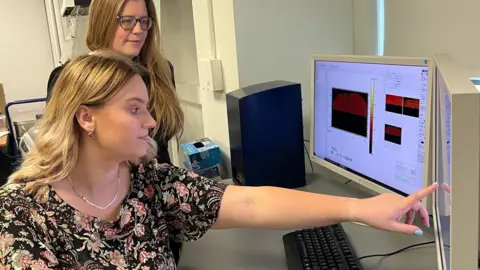'Watching paint dry isn't boring, we invented some'
 Supplied
SuppliedScientists have spent "a large amount" of time watching paint dry as part of their research to create a new bacteria-busting substance.
The antimicrobial paint, which contains the disinfectant Chlorhexidine, has been found to kill bacteria which is usually resistant to disinfectants - including standalone Chlorhexidine.
Dr Felicity De Cogan and PhD student Madeline Berrow watched the paint "time-cure" with and without the disinfectant added, to make sure it still behaved and dried the same.
If it gets regulatory approval, the pair intend for the paint to be used in medical and public spaces which need cleaning or disinfecting - ranging from hospitals to toilets.
Dr De Cogan, from the University of Nottingham, said the idea for the paint stemmed from the coronavirus pandemic to kill Covid-19 on surfaces.
"Although it's taken us several years, and we're no longer in the pandemic, I still think it has so many uses," Dr De Cogan added.
 Supplied
SuppliedMs Berrow said the project was "exciting" despite the hours watching paint dry.
"It's good to see such hard work [be successful]. A lot of blood, sweat, and tears have gone into this project and it's nice to see something has really come alight from it," she said.
"We can actually see it being used in industry to reduce disease transmission, which is what we wanted."
The project is a partnership between the university and the company Indestructible Paint.
 Supplied
SuppliedThe scientists said they were uncertain why the Chlorhexidine disinfectant is more effective inside the paint than on its own, which will take more research.
However, Ms Berrow said it would be a good alternative to other antimicrobial surfaces because it does not need "specialised" installation.
Any prospective user could simply paint it on.
Brian Norton, managing director of Indestructible Paint, said it could provide a "huge benefit" for coating areas where bacteria is known to grow, such as aeroplane seats and tray tables.
"It's still in the early stages but we look forward to further testing," he said.
Follow BBC Nottingham on Facebook, on X, or on Instagram. Send your story ideas to [email protected] or via WhatsApp on 0808 100 2210.
